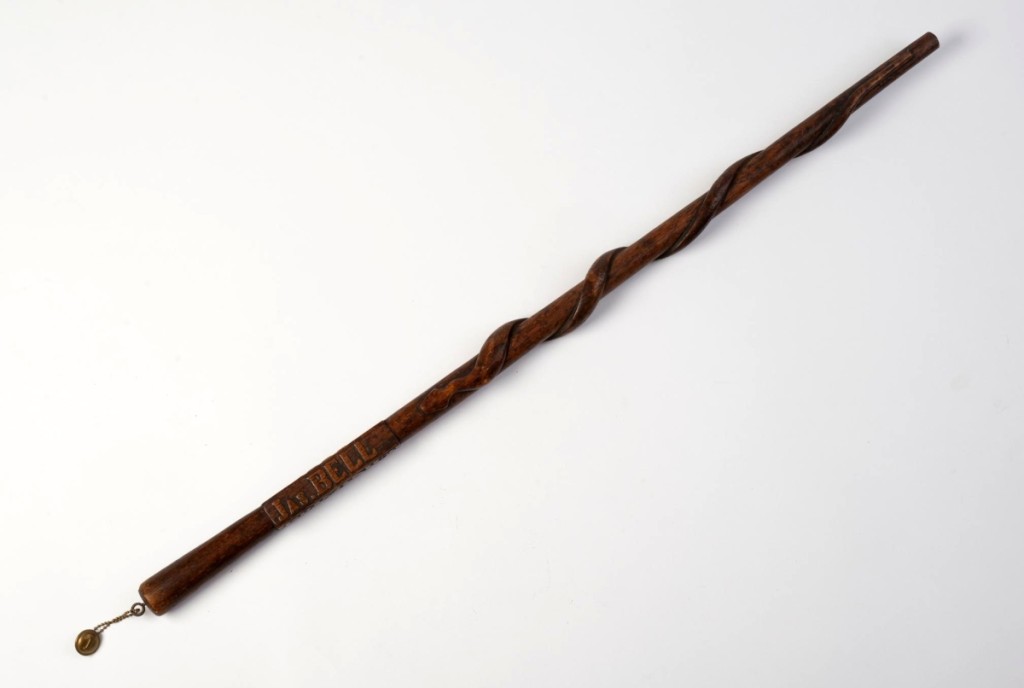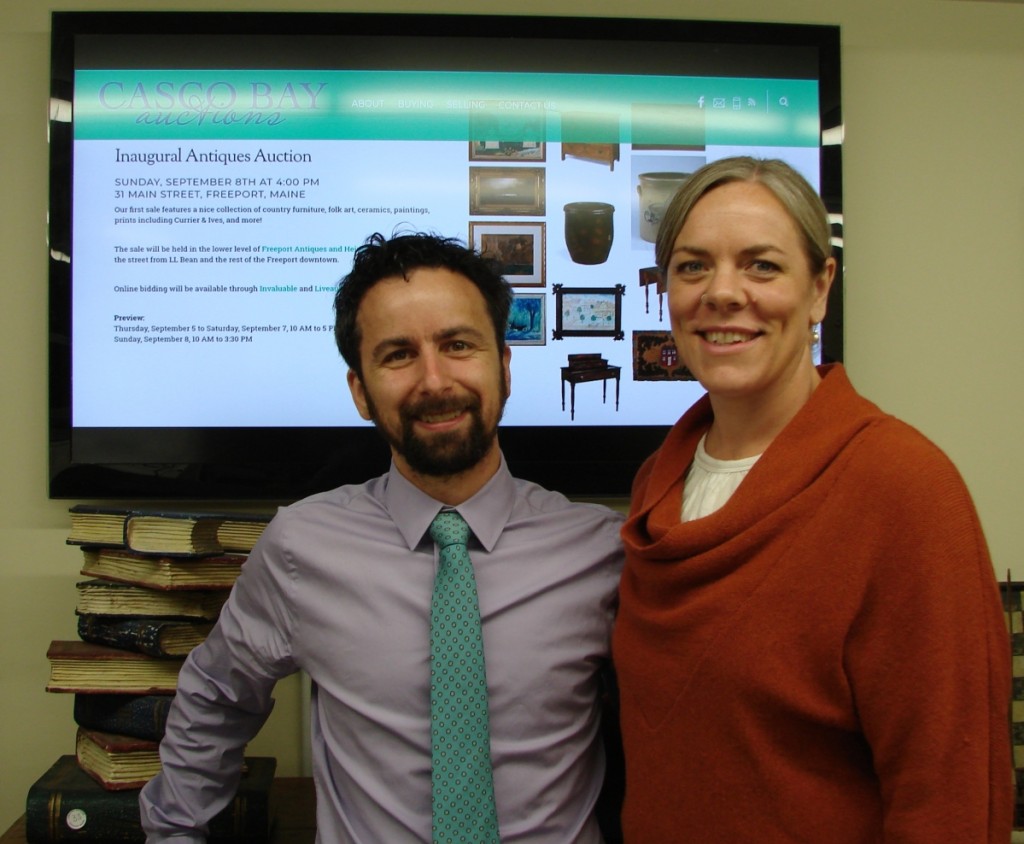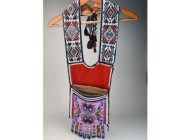Review and Onsite Photos by Rick Russack, Additional Photos Courtesy of Casco Bay Auctions
FREEPORT, MAINE – Freeport is a shopper’s paradise, home to L.L. Bean and countless other upscale retailers and outlets. It now has an antiques center, which opened in May 2018, developed by Linda Bean, and that antiques center was the site for Andrew Davis and his new company’s debut auction on September 8. The site was a good choice – Main Street in the town, already known to antiquers in the area and inside a historic 1829 Greek Revival home. It has been redeveloped specifically for its current purpose. The new company, Casco Bay Auctions, is a family affair. Davis’ wife Megan is involved and enthusiastic, and other members of the family assisted at the first sale.
The few glitches were minor, mostly related to the staff getting accustomed to the two internet platforms in use. There were about 50 people in the audience, including auctioneers Ron Bourgeault and Jim Horan. Andy Davis, 35 years old, worked for them for about 15 years part time, doing photography, catalog design, website development, cataloging and “whatever else needed to be done.” Davis lives in Freeport and Bourgeault introduced him to Linda Bean at one of his sales last summer. With that business changing direction, Davis decided to go in business for himself, and Bean rented him space for the sale. Davis has a degree in art history from the University of Southern Maine. Megan works for the YMCA in Freeport and they have two children, six and ten years old, who also seem to enjoy the prospect of the new auction business.
This sale included folk art, painted and other furniture, woodenware, stoneware, paintings, Currier & Ives prints, trade signs and an eclectic selection of other material. Bringing one of the top prices of the day was a 33-inch walking stick that had belonged to a Confederate soldier. It was carved with a snake and the inscription “Jas. Bell/Prisoner of War/1862.” Bell, from Richmond County, Ga., enlisted in 1861 as a private and was listed as a prisoner of war in Sharpsburg, Md., in 1862. The cane sold for $1,409. Davis later said the piece is going back to Georgia.
A bidder in the room, with stiff competition from an internet bidder, paid $1,323, well over the estimate, for a redware jar cataloged as Maine, circa 1820-50. The buyer, a dealer, left immediately after making the purchase, and was asked what made the jar important. He said, “You mean you’re wondering why I paid that much for a jar with a chunk missing. I think it’s actually from western New York state, and the three-color glaze makes it really special.”
There were some good buys in the folk art selection. A large, well-carved gargoyle head brought $345. It had been removed from the Passaconway Inn in Cape Neddick, York, Maine, when that building was demolished in the 1930s. Also seemingly a good buy was a naive, homemade child’s rocking horse, which brought only $230. Two items with fish themes were included; one a carved trout plaque and the other a crusty old buoy that had been made into a trade sign. The carved trout plaque was 22 inches long and had a label reading “W.S. Joseph S. Stickney / Saco, Maine / 1929” It brought $892. The trade sign that had been made from a buoy had an old red and white surface, fins, gills and tail made from sheet metal and teeth that looked like old nails. It was lettered in black, “Chamberlain.” It sold for $202. It will probably be back, but probably for quite a bit more money.

One of the highest priced items in the sale was a Confederate walking stick, carved with a snake and the inscription “Jas. Bell/Prisoner of War/1862” which realized $1,409. Bell, from Georgia, was a prisoner of war in the Union prison in Sharpsburg, Md., in 1862.
Another piece of folk art that seemed reasonable was a carved wooden lamb with numerous carved “ringlets” of wool. It had a well-carved head, was 9 inches tall and brought $230.
Perhaps the most unusual offering that might be included in the folk art category was a group of four earthenware moustaches in different styles, meant to be displayed on a wall, the largest of which was 17 inches long. They had had been made by British artist Richard Slee (b 1946). The website of the Victoria and Albert Museum referring to Slee, states, “The ‘Grand Wizard of Studio Ceramics’, Richard Slee is one of Britain’s most important contemporary ceramic artists.” The group of four, each signed on the back, realized $805.
Furniture included a group of six candlestands, being deaccessioned by Strawbery Banke. Some were passed, some not expensive, with the best-liked one of the group earning $180. It was described as circa 1830 with cabriole legs ending in pad feet. There were several other pieces of “brown” and painted furniture. A grain-painted four-drawer chest, with G.K.S. Bush in its provenance, earned $690. A red and black decorated Maine dressing table went out for $219. A maple secretary on a bracket base with four drawers and paneled doors sold for $604, and a tiger maple drop leaf table on nicely turned legs earned $185. Woodenware painted blue was popular with the crowd. A blue staved Shaker bucket with iron bands brought $265, and a blue painted covered pantry box with a bail handle finished at $345. A blue butter churn, stenciled with “Cylinder Churn / Manufactured for / Kendall & Whitney / Portland, ME.” went for $161.
Davis is already planning the next sale, which will probably be conducted in late November. He said, “There were some nice surprises in this sale. I didn’t expect the redware jar to bring the price it did, and it’s nice to know that the Confederate walking stick will be going back home. We didn’t have any of the surprises you don’t want to have for a first sale; no major problems and things went pretty smoothly.
We have a good collection of scrimshaw for the November sale, along with some good stoneware, some nice decoys and some Liverpool jugs. We’re looking forward to it. I think there’s room for another auctioneer in this part of Maine. So many collectors are downsizing and there are plenty of good estates. We’ll have plenty of good stuff.”
Prices given include the buyer’s premium as stated by the auction house.
For information, 207-370-4746 or www.cascobayauctions.com.



























